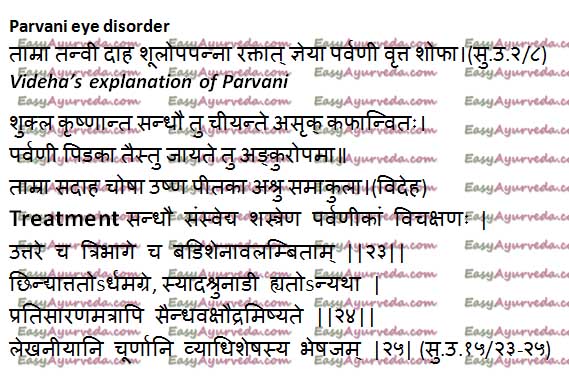Parvani Eye Disorder Definition, Location, Symptoms, Treatment
Article by Dr Raghuram Y.S. MD (Ay) & Dr Manasa, B.A.M.S
Parvani is an eye disorder affecting the sclero corneal junction – meting place of black and white part of the eye. It is correlated with marginal ulcers of Cornea (Keratitis Marginalis), Keratitis Marginalis Superficialis and Diciform Keratitis
Table of Contents
Introduction
Parvani – Quick look about the disease
Specific location – Krishna-Shukla Gata Sandhi – Sclero-corneal Junction (junction of black and white of the eye)
Classification based on the location – Parvani is a Sandhigata Roga i.e. disease occurring in the junction of the eye
Related reading – Netra Sandhi Gata Rogas
Classification based on Predominant Dosha – Parvani is a Raktaja Netra Roga i.e. caused by vitiated blood
Classification based on prognosis – Parvani is a Sadhya roga i.e. curable disease
Classification based on predominant treatment / surgical process used in combating the disease – Parvani is a Chedya Netra Roga i.e. curable by administration of chedana i.e. excision or cutting

Definition, meaning
Parvani, definition and meaning
Parvani is a thin, circular and red colored swelling (protuberance, growth) occurring at the sclera-corneal junction, i.e. at the junction of the black portion and white portion of the eye (Krishna-shuklagata sandhi).
Parvani – Parvani is a netra sandhigata roga (diseases occurring at the junctions of the eye parts) in which thin, circular and copper colored (red colored) swelling (protuberance, growth) occurring in the Krishna-shukla gata sandhi (sclera-corneal junction).
Parvani is caused by vitiated blood and is associated with burning sensation and pain.
Videha’s explanation of Parvani
The vitiated rakta (blood) and kapha get accumulated in (lodged in) the shukla krishna gata sandhi (junction between the white of the eye and black of the eye, sclera-corneal junction). On getting lodged in the mentioned location, the vitiated doshas produce blisters (eruptions, pidaka) which resemble sprouts (ankura upama). This condition is called Parvani. The color of the pidakas is coppery. Parvani is associated with burning sensation, sucking pain, raise in temperature (hot tears) and yellow colored discharges (tears).
Symptoms
Symptoms of Parvani
Tanu Vritta Shopha – thin circular swelling (protuberance, growth) occurs at the junction of Krishna bhaga (black of the eye, iris) and shukla bhaga (white of the eye, sclera)
Ankuropama Pidaka – blisters or eruptions resembling sprouts (Videha)
Tamra – the swelling at the sclera-corneal junction is of coppery color (red colored)
Dahopapanna – presence of burning sensation in the region of protuberance
Shulopapanna – pain in the region of the growth
Chosha – sucking pain
Ushna – heat in the swelling (hot tears)
Pita ashru – yellow colored tears
Modern correlation
Parvani can be correlated to –
- Marginal ulcers of Cornea (Keratitis Marginalis)
- Keratitis Marginalis Superficialis
- Diciform Keratitis
Treatment
Treatment of Parvanee
Sushruta has indicated Chedana or excision (cutting) followed by pratisarana (application) of medicaments in Parvani.
Chedana – Firstly the Krishna-shuklagata sandhi (sclera-corneal junction) should be subjected to swedana (steaming, sweating treatment). The upper 1/3 portion of the swelling (protuberance, growth) should be held by a badisha shastra (sharp hook like instrument with a bent blade) and pulled out. This portion should be held in position. Later half of the front portion of the swelling (middle portion) should be cut (excised) with sharp blade, taking care that more than required portion is not cut. If the excision is made in excess, it may lead to formation of sinus in lacrimal apparatus (ashru nadi).
Pratisarana – After excising the required portion of swelling (protuberance, growth), the remaining portion should be rubbed (applied, pratisarana) with mixture of saindhava lavana (rock salt) and madhu (honey).
Anjana and Pratisarana with Lekhaniya Churnas – In spite of doing chedana and pratisarana, if the disease doesn’t get cured in totality anjana (collyrium) or pratisarana (rubbing) should be done using powders with scraping property.
Click to Consult Dr Raghuram Y.S. MD (Ayu) – Email / Skype






